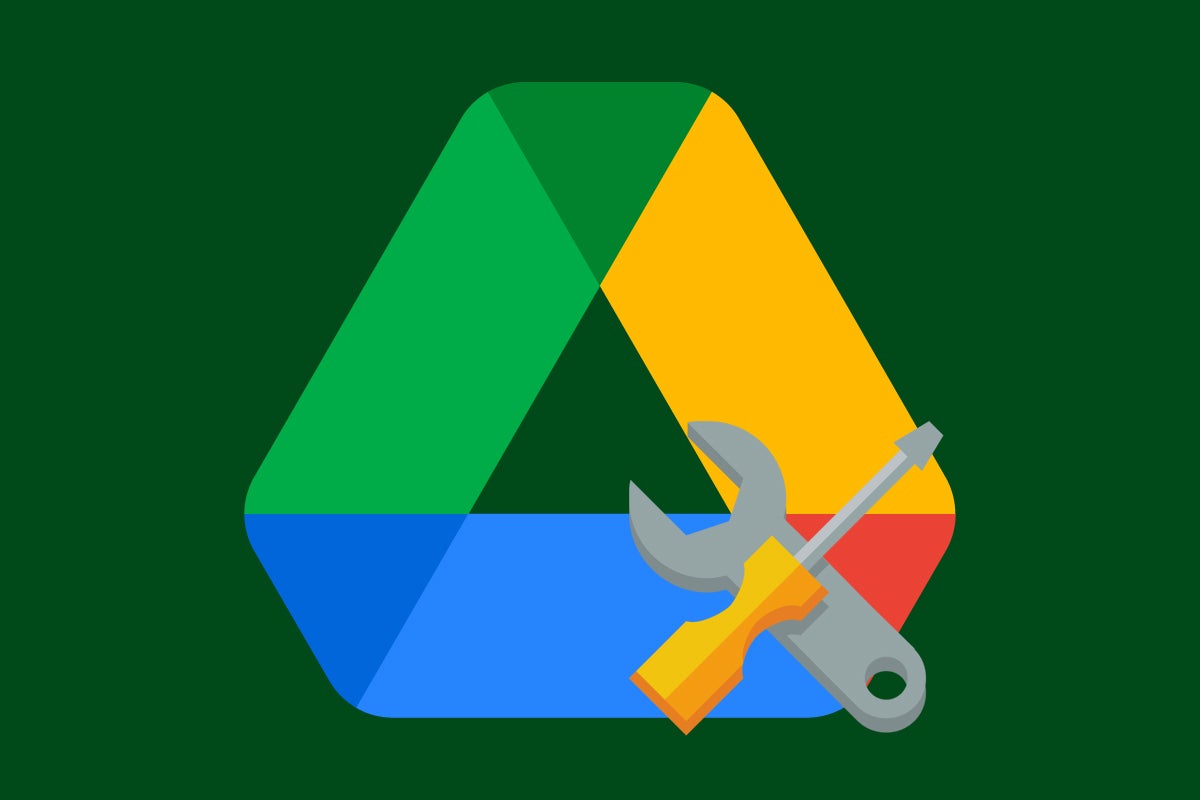Ah, the cloud. It sounds so light, so fluffy, so worry-free — doesn’t it?
Here in the real world, though, cloud services aren’t always so simple. With Google Drive, specifically, whether you’re storing and managing multimedia assets or dealing with documents and spreadsheets, there’s a decent chance you’ll run into some manner of murkiness along the way.
Drive does lots of things well, but it certainly has its share of, shall we say, quirks. I’ve heard it all over the years — and now, I’ve put together a collection of some of the most common Drive challenges I’ve encountered along with some fast ‘n’ simple solutions to overcome ’em.
Read through these fixes, hang onto any that seem relevant for future reference, and get ready to watch your cloud-related worries float away.
Google Drive problem #1: Difficult downloads
For something that’s primarily a storage service, you’d think the basic act of, y’know, transferring files with Drive would be effortless. Unfortunately, though, Drive is somewhat notorious for making downloads a massive pain in the patootie — at least, when more than one file is involved.
When you select multiple files on the Drive website and then try to download ’em all simultaneously, the site begins to package the files into a compressed zip archive — and then, all too often, takes an eternity to finish that process and start your actual download. It’s a frequently frustrating experience and the last thing you want to deal with when you’re just trying to save some stuff and move on.
There’s not much you can do about the process itself, but you can avoid the website entirely and transfer files in a simpler, faster, and more reliable manner. You’ve got a few different options, all of which put the Drive website method to shame.
First, if you’re using Chrome OS, the function you need is built right into your Chromebook: Just open up the system Files app, find the Google Drive section in the left-hand menu, and drag and drop any folders or files between there and your local storage.
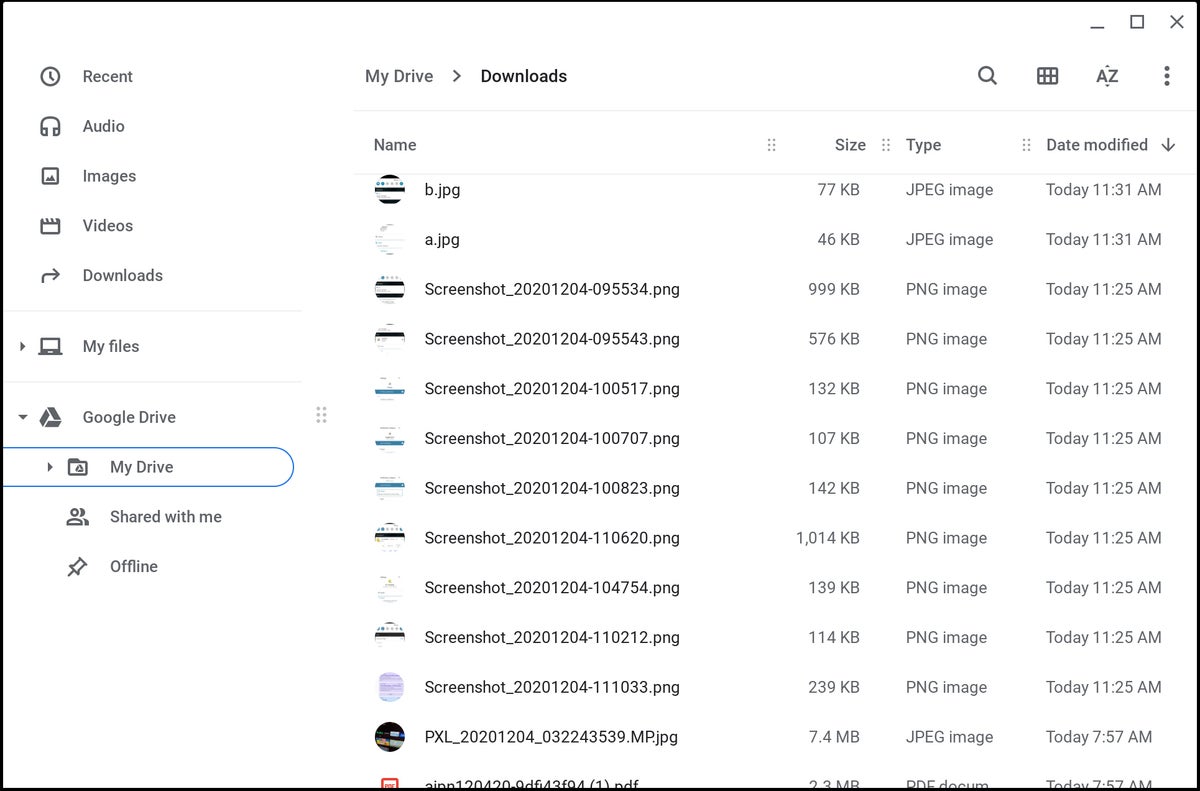 JR Raphael/IDG
JR Raphael/IDGThe Chrome OS Files app has native Drive integration for easy file transfers. (Click image to enlarge it.)
On a Windows or Mac computer, grab Google’s official Backup and Sync program or the team-based File Stream alternative for managed enterprise environments. You can then set the program up to keep any folders from your Drive storage synced to your computer’s storage — so a folder on your computer basically becomes a mirror for the equivalent folder in Drive. Anything you save to it or drag to it will automatically get uploaded to Drive, and the local folder and the Drive folder will always be identical.
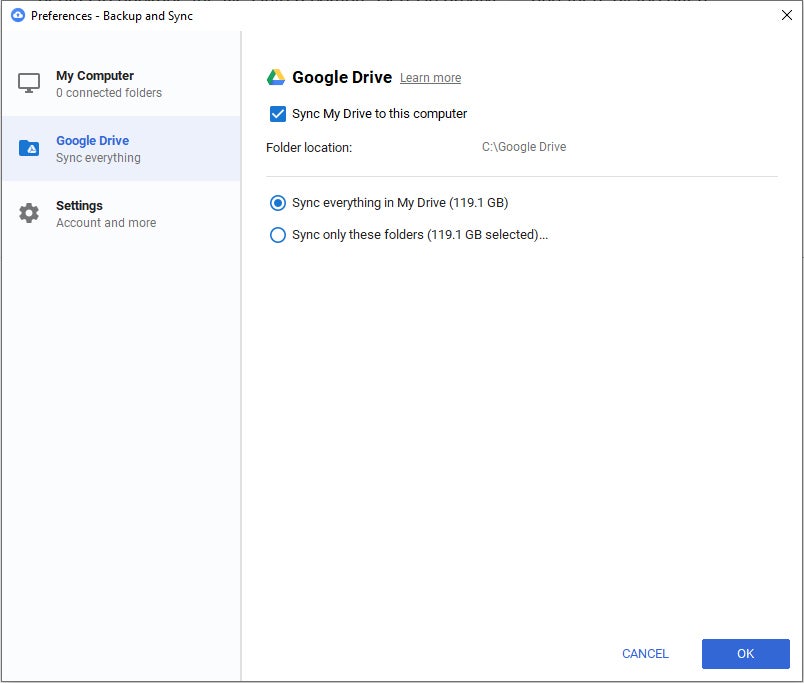 JR Raphael/IDG
JR Raphael/IDGGoogle’s official Backup and Sync program makes it super-simple to move files back and forth between Drive and a Windows or Mac computer. (Click image to enlarge it.)
And finally, if you want to get really geeky, you can actually use an FTP program to sign into your Drive account and then drag and drop things directly between it and your computer without any annoying interfaces or unnecessary time-wasters. If that sounds too complicated or confusing for you, then it’s probably not something you need. But if you use FTP in other parts of your life and find the possibility alluring, the specific program you’ll want to grab to make it happen is a free and open-source FTP client called Cyberduck. It’s available for both Windows and Mac (and there’s really no need for it on Chrome OS, since the same basic capability is built directly into the system file manager on that platform).
Once you’ve installed the program, click the Open Connection button, select “Google Drive” from the dropdown menu at the top of the connection box, then click Connect. A page will pop up in your browser prompting you to allow the app access to your Drive storage, after which you’ll be given a special code that you’ll need to copy and paste back into a prompt that’ll be waiting for you in the app.
After you’ve done that, you’ll have a file-system-like view of your Drive storage right in front of you — and you can drag and drop anything from your computer into it or anything from it into a local computer folder.
As an extra-geeky bonus, Cyberduck can do the same thing with both Dropbox and OneDrive as well, in case you have any need to connect to either of those services.
Google Drive problem #2: Office awfulness
I don’t know about you, but I tend to get a whole lot of Word files sent my way. And since I long ago sent Microsoft’s Office apps a-packin’ and switched over to Google Docs for all of my own writing, I usually end up dragging those files into the Drive website to open ’em and do whatever’s needed within my preferred environment.
For years, Drive relied on a Chrome-connected system called Office Compatibility Mode to make that possible. It’s a stripped-down interface where you can view and perform basic edits on Office files but where most advanced word processing features — including commenting — are missing in action. And quite honestly, it’s kind of irritating to use.
There’s actually a much better option, though — one you’d probably never know existed if you’ve been using Drive for long enough to have that Compatibility Mode system in place. So here it is: Since mid-2019, Drive has supported native Microsoft Office file editing within the standard, fully featured Google Docs interface and without any conversions or stripped-down setups required.
If you’re still seeing that old Compatibility Mode when dragging Office files into the Drive website, all you’ve gotta do is remove the Office Editing extension from your browser — by opening its Chrome Web Store page and clicking the Remove from Chrome button (which will be present if the extension is installed) — and then refresh the Drive website, if you already had it open. The next time you drag an Office file into the site, Drive will automatically open it in an editor that looks and works exactly like the regular Docs editor, only with a blue “.DOCX” chip next to the file’s name to let you know you’re using the Word format. (Just note that somewhat confusingly, you need to drag the file into the Drive website, not upload to the Docs website, for this to work.)
 JR Raphael/IDG
JR Raphael/IDGWorking with Office files in Drive is a delight — once you get everything set up correctly. (Click image to enlarge it.)
The file will remain in its original format throughout any edits you make. If you need to export it to send it back to someone after editing, you can always download or share it from Drive or directly from the Docs editing interface. (And while we’re been talking about documents specifically here, by the way, all of this same stuff applies to Excel and PowerPoint files as well.)
Just one last thing to check: Drive has an option within its settings (which you can find by clicking the gear-shaped icon in the Drive site’s upper-right corner and then selecting — yep, you guessed it — “Settings”) that’ll automatically convert all uploaded documents into the Docs editing format. That typically isn’t enabled by default, but if you want to make sure any Word files remain in the Word format, as described above, you might want to take a quick peek and confirm that that option is indeed deactivated on your account.
Google Drive problem #3: Conversion challenges
Speaking of file formats, have you ever found yourself staring at a file in your Drive and wishing you had a way to turn it into some other type of file? Whether it’s a document you need to transform into a PDF, a PNG you need to morph into a JPG, or a WAV you want saved as an MP3, moving from one manner of file to another is a delicate and often difficult dance.
It doesn’t have to be, though. First of all, if the conversion you need revolves around any manner of standard text file — PDF, RTF, DOCX, TXT, or even HTML or EPUB — you can actually handle your transformation directly within Docs. Just open the file into Docs (either by double-clicking it within Drive, if it already has the Docs icon next to it and is set to open there by default, or by right-clicking it and then selecting “Open with” followed by “Google Docs” if not).
From there, if the file is a PDF, it’ll automatically get converted into a plain-text document on the spot. If it’s any other type of file, you can click “File” followed by “Download” to find options for saving it into an alternate format.
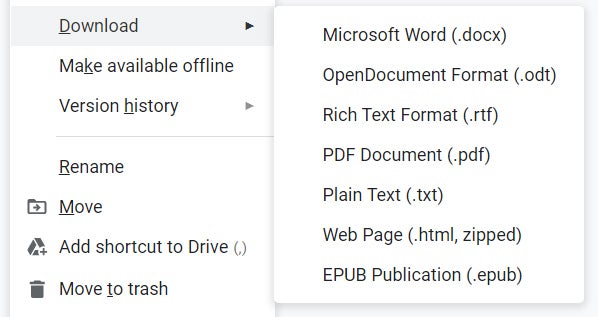 JR Raphael/IDG
JR Raphael/IDGYou can convert documents into lots of other file types directly within the Google Docs editor.
But what if you’re dealing with something beyond a basic text file? The answer there lies within an ultra-handy Google Drive add-on called CloudConvert. Open up the add-on’s page within the Google Workspace Marketplace, click the button to install it, and follow the steps to add it into your account.
You’ll see some warnings about the level of access you’ll be granting the service, but don’t fret: First of all, CloudConvert will have access only to the Drive files that you explicitly send to it or create with it, not to your entire Drive storage — and second, the company’s privacy policy makes it clear that it never reads or collects data from uploaded files or does anything shady with your info. (The company makes its money by selling subscriptions, but unless you anticipate doing more than 25 file conversions a day, you won’t have to pay to use it.)
After you’ve got that added, you can right-click on any file within Drive and then select “Open with” followed by “CloudConvert” to select a new format and begin a conversion. The resulting file will be saved back into your Drive storage as soon as it’s finished.
Google Drive problem #4: Mobile syncing
The Drive syncing systems we talked about a minute ago are great on the desktop front — but when you’re using Drive from your phone, you’re much more limited in options.
Sure, you can use the Drive app’s built-in “Make available offline” function — which you can find by tapping the three-dot menu icon alongside any individual file — if you need to keep specific Drive files accessible on your device even when you aren’t online. If you want to actually sync entire folders in either direction, though, or have any files available for use outside of Drive itself, the official app won’t be of any help.
On Android, an app called Autosync for Google Drive will fill that void. It’s among my picks for the best Android file management apps around, in fact, and for good reason: The app makes it as easy as can be to create pairs of folders that are continuously synced between your Drive storage and your phone — in both directions, in just one direction, or even in an upload-and-then-delete sort of arrangement. You just pick out the local folder and the Drive folder you want to use, select the appropriate parameters, and then sit back and let the app do its work silently in the background over time.
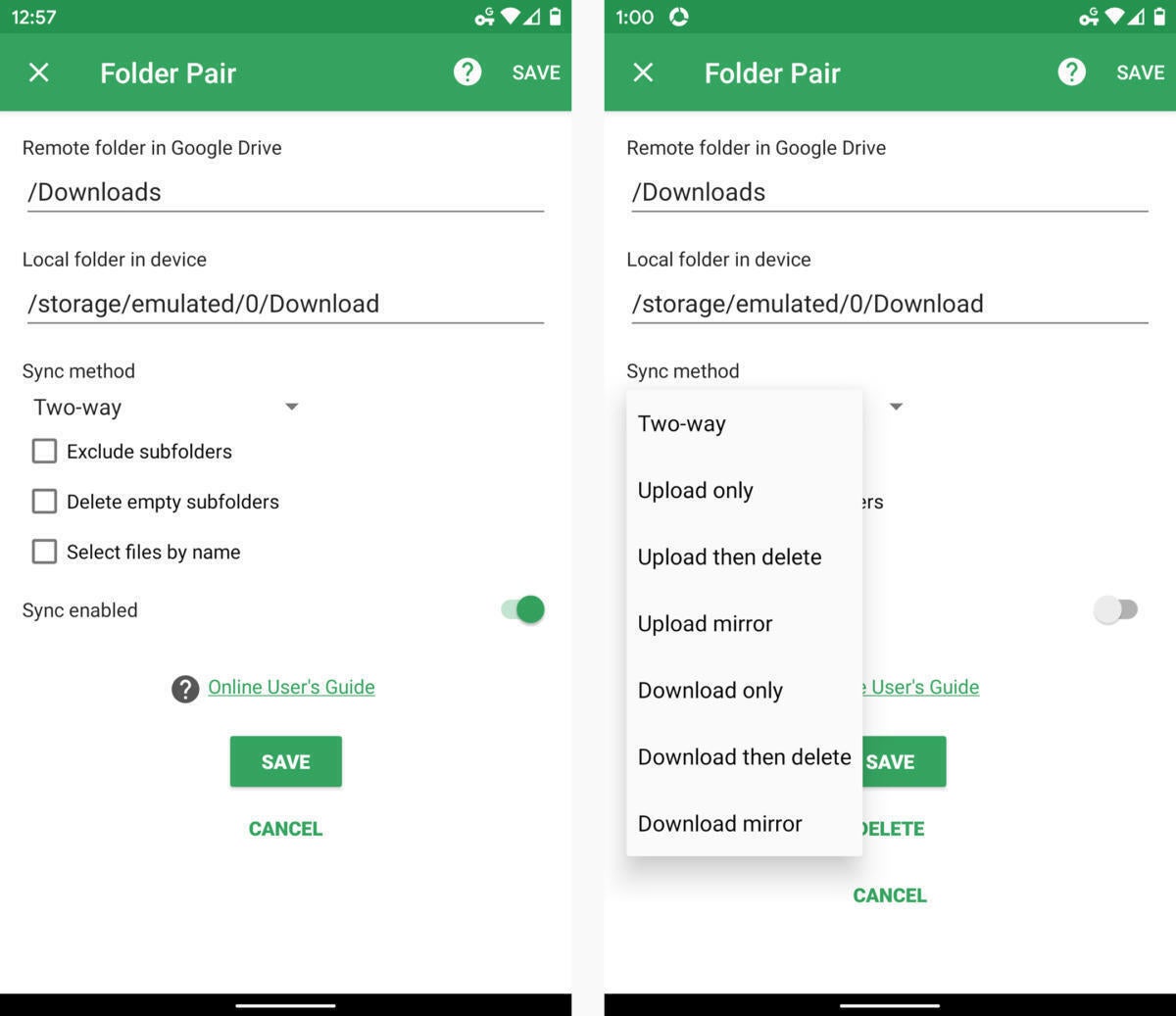 JR Raphael/IDG
JR Raphael/IDGAutosync lets you keep folders synced between Drive and your Android device.
Autosync is free to use for a single folder pairing and with files that are 10MB or smaller. You can remove those restrictions and unlock other advanced features with a one-time $5 in-app payment.
Google Drive problem #5: Quick Access irritation
Drive’s Quick Access panel — that big strip o’ suggested files at the top of the website’s main page — is meant to make it faster for you to pull up items you’ve accessed recently or that Google for some reason thinks you’re likely to be looking for soon. If it seems more like wasted space than a helpful resource for you, though, take note: You can disable it.
It’ll take you all of 10 seconds to do: Click the gear-shaped icon in the upper-right corner of the Drive website, select “Settings,” then scroll down within the first section until you see “Suggestions.” Uncheck the box next to it, and bam: Just like that, Drive’s Quick Settings will be out of your life forever.
Google Drive problem #6: The buried file blues
We all have those perpetually important files — documents, images, and other resource-like items we pull up all the time. And always having to search for said VIP files to find ’em isn’t exactly fun or productive.
Drive doesn’t have any way to pin files to the top of a list, but it does have some helpful tools for treating certain files as high priority and making them especially easy to find and access. First, you can star any file (or even an entire folder) by right-clicking it and selecting “Add to Starred” on the Drive website or by tapping the three-dot menu icon alongside it and then selecting that same option within the Drive mobile app. Doing so will cause the item to appear in a special starred section that you can then get to by clicking the “Starred” option in the main left-of-screen menu or by bookmarking this direct link for the desktop — or by tapping the star-shaped icon within the main bottom-of-screen menu in the mobile app.
You can also create your own custom shortcuts for files or folders so that they effectively appear in multiple places — if, say, you have an important item that’s buried a few folders deep in your Drive. By creating a shortcut for it, you could make it available from the main “My Drive” list while technically still leaving it in its properly organized home. Just right-click on any file or folder and select “Add shortcut to Drive” to get started with that from a computer; tap that three-dot menu icon next to any item to find the same option on mobile.
If you’re using Android, you can also add a direct shortcut to any file or folder right onto your phone’s home screen for one-touch access without even having to open the app. Tap the three-dot menu icon alongside the item you want, then scroll down and look for the “Add to Home screen” option to give it a whirl.
Whew — that pesky ol’ cloud is sure starting to feel a heck of lot lighter, isn’t it? For even more on-the-spot tech troubleshooting, click over to some of my other recent “fast fixes” guides:



